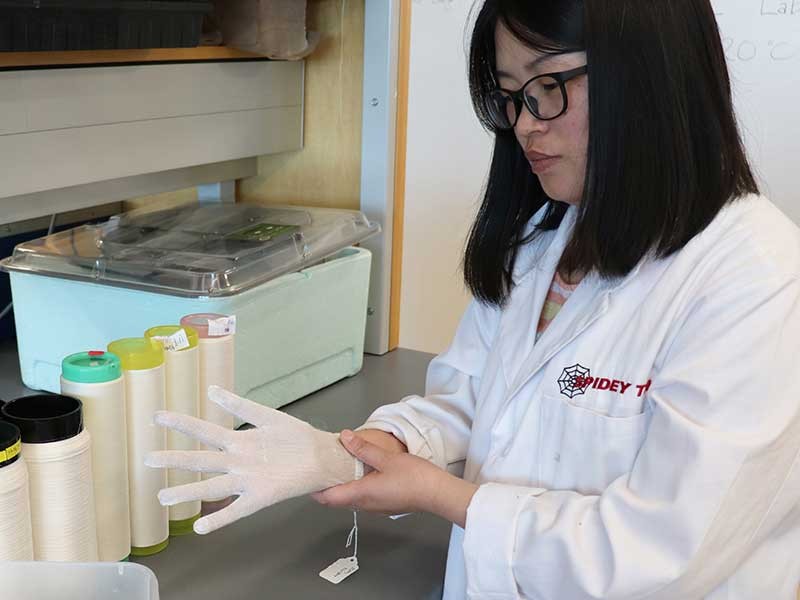USU Researchers Use CRISPR to Advance Synthetic Spider Silk Manufacture
By Mary-Ann Muffoletto |
USU Postdoctoral Fellow Xiaoli Zhang tries on a glove knitted from synthetic spider silk produced by transgenic silkworms. The lab's researchers used CRISPR technology to insert the spider protein into the silkworms.
Spider silk is an engineer’s dream material. Lightweight, strong, elastic and biocompatible, it’s an ideal building block for a myriad of applications, including medical implants, body armor and vehicle components. But trying to farm spiders, which eat each other and yield relatively small quantities of silk, is impractical.
Utah State University researchers, under the direction of USU USTAR Professor Randy Lewis, have pioneered initial, lab-scale production of synthetic spider silk through the use of transgenic goats, bacteria, alfalfa and silkworms. Now, the researchers are using emerging CRISPR technology to harness the spinning power and efficiency of silkworms. Their results demonstrate promise for use of transgenic silkworms as natural spider silk spinners for industrial production of high-performance fibers.
Lewis and team members Xiaoli Zhang, Linjin Xia, Breton Day, Thomas Harris, Paula Oliveira and Justin Jones, along with colleagues at Pennsylvania’s Drexel University and China’s Soochow University, published their findings in the May 6, 2019, issue of the American Chemical Society’s Biomacromolecules journal.
“Developing a way to spin synthetic spider silk fibers in a consistent, high quality, cost-efficient and environmentally friendly way for commercial-scale production has been a challenge,” says Zhang, lead author on the paper and postdoctoral fellow in USU’s Department of Biology.
The project is the team’s first attempt with CRISPR/Cas9 – short for “Clustered regularly interspaced short palindromic repeats and CRISPR-associated protein-9 nuclease” – a variation of a naturally occurring immune system found in bacteria. Like a pair of molecular scissors, CRISPR/Cas9 enables gene editing.
“Prior to using CRISPR, our attempts to insert spider protein DNA into transgenic hosts were somewhat random,” Lewis says. “CRISPR offers much more precision.”
And that precision is paying off. The researchers are reaping the spinning benefits of silkworms, organisms used for centuries by humans for silk fiber production. But they’re also discovering the offspring of CRISPR/Cas9-assisted transgenic silkworms, and subsequent generations of offspring, are retaining the spider silk protein genes.
“This is a breakthrough,” Lewis says. “Before CRISPR, offspring from transgenic worms eventually lost the spider silk genes.”
To test the effectiveness of transgenic spider silk protein inheritance, Zhang inserted green and red fluorescence gene tags before and after the spider silk genes in the transgenic silkworms’ DNA sequence. Her investigation also revealed spider silk generated by the offspring of transgenic silkworms is getting stronger.
“We found the incorporation of spider silk protein isn’t disrupting the structure of silkworm protein,” Zhang says. “In fact, the spider silk protein is adding to the crystallinity and thus, mechanical properties of the transgenic silkworms’ silk, particularly strength.”
Vintage spinning machinery meets emerging CRISPR technology: USU researchers, from left, Randy Lewis, Justin Jones and Xiaoli Zhang investigate use of transgenic silkworms for commercial-scale production of high-performance synthetic spider silk.
WRITER
Mary-Ann Muffoletto
Public Relations Specialist
College of Science
435-797-3517
maryann.muffoletto@usu.edu
CONTACT
Justin Jones
Assistant Professor
Department of Biology
435-797-9292
justin.a.jones@usu.edu
ADDITIONAL RESOURCES
TOPICS
Research 878stories Biology 165stories Innovation 90stories USTAR 64stories Genetics 63stories Spider Silk 19storiesComments and questions regarding this article may be directed to the contact person listed on this page.








